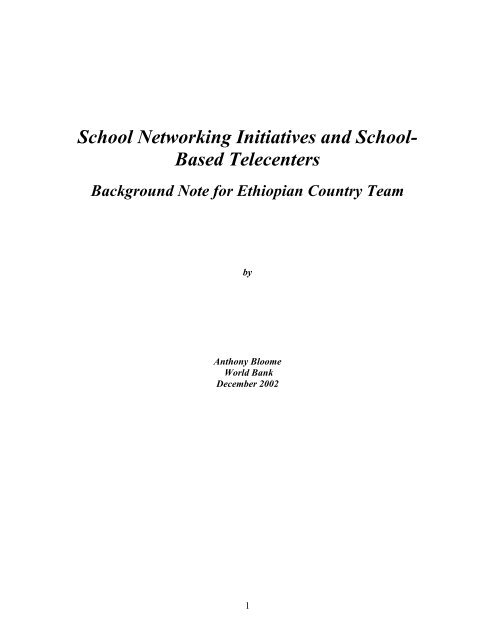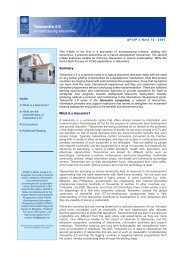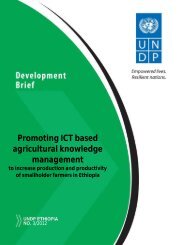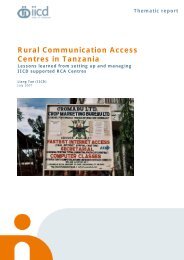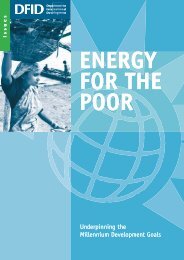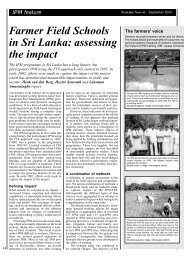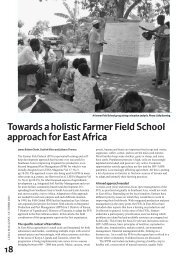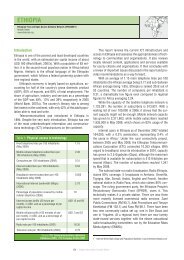School Networking Initiatives and School- Based ... - Share4Dev.info
School Networking Initiatives and School- Based ... - Share4Dev.info
School Networking Initiatives and School- Based ... - Share4Dev.info
Create successful ePaper yourself
Turn your PDF publications into a flip-book with our unique Google optimized e-Paper software.
<strong>School</strong> <strong>Networking</strong> <strong>Initiatives</strong> <strong>and</strong> <strong>School</strong>-<br />
<strong>Based</strong> Telecenters<br />
Background Note for Ethiopian Country Team<br />
by<br />
Anthony Bloome<br />
World Bank<br />
December 2002<br />
1
Table of Contents<br />
Section I: About <strong>School</strong> <strong>Networking</strong> <strong>Initiatives</strong>…………………………………….. 3<br />
Introduction to <strong>School</strong>Nets ……………………………………………3<br />
<strong>School</strong>Nets in Africa……………………………………………………5<br />
Section II: About Telecenters …………………………………………………………8<br />
<strong>School</strong>-based Telecenters…..…………………………………………..9<br />
Section III: Ethiopian Country Context……………………………………………..12<br />
Appendices<br />
Ug<strong>and</strong>a’s Wireless <strong>School</strong> Internet Connectivity (article)<br />
Ug<strong>and</strong>a <strong>School</strong>-<strong>Based</strong> Telecenters: An Approach To Rural<br />
Access to ICTs (article)<br />
The Bindura Internet Learning Center: Modest in Size, but<br />
Mighty in Impact (article)<br />
2
This draft report provides a brief overview of school networking or “schoolnet” initiatives<br />
(Section I: About <strong>School</strong>Nets) <strong>and</strong> background <strong>info</strong>rmation on community telecenters,<br />
particularly those located in educational institutions, notably school-based telecenters (Section II:<br />
<strong>School</strong>-<strong>Based</strong> Telecenters). <strong>Based</strong> on further analysis of country-specific data, a final section has<br />
been provided with extension of these models to the Ethiopian country context. (Section III:<br />
Ethiopia Country Context).<br />
Section I: About <strong>School</strong>Nets<br />
A. Introduction to <strong>School</strong> <strong>Networking</strong> <strong>Initiatives</strong><br />
(Because of its relevance to the topic, Section A has been drawn in its entirety from <strong>School</strong><br />
<strong>Networking</strong> in the Pacific Isl<strong>and</strong> States: An environmental scan <strong>and</strong> plan for the establishment, of<br />
schoolnets for the Pacific isl<strong>and</strong> states, Denis Br<strong>and</strong>jes, Johannesburg, South Africa April 2002) 1<br />
In recent years there has been an increased emphasis on the use of technology to address<br />
developmental concerns throughout the world. The education sector has attracted a large part of<br />
this attention, which is centered on the use of <strong>info</strong>rmation <strong>and</strong> communication technologies<br />
(ICTs) to address teaching, learning <strong>and</strong> administrative needs. For the purposes of this report,<br />
<strong>info</strong>rmation <strong>and</strong> communication technologies refer to computers, networks, the Internet, <strong>and</strong><br />
broadcast <strong>and</strong> related technologies that enable <strong>info</strong>rmation <strong>and</strong> communication flow <strong>and</strong><br />
processing.<br />
The use of ICTs beyond technical <strong>and</strong> vocational development was initially promoted in the<br />
educational sector as a tool to support tertiary education. It was applied particularly in revising<br />
distance education methodologies in order to ensure larger <strong>and</strong> more varied access to education.<br />
The result has been a proliferation of courses <strong>and</strong> qualifications on offer by an increasing number<br />
of institutions in a variety of formats supported by technology, many through the Internet. This<br />
has increased accessibility to education in communities that were previously excluded. However,<br />
the “digital divide,” the gap that exists between those who have access to ICTs <strong>and</strong> those who do<br />
not, continues to limit the advantages of these technologies to those who have the finances,<br />
infrastructure <strong>and</strong> expertise to support them.<br />
The extension of the use of ICTs into the primary <strong>and</strong> secondary education system followed, as<br />
practitioners saw the benefits of the various technologies. The use of computer hardware <strong>and</strong><br />
software in the school environment can be traced to the late seventies <strong>and</strong> early eighties, where<br />
the use of basic software <strong>and</strong> games on equipment such as the BBC Micro, Apple, Acorn <strong>and</strong><br />
Atari was encouraged in a few schools, particularly in Europe <strong>and</strong> North America. Another large<br />
initial driver was the introduction of Computer Studies as part of the curriculum in numerous<br />
countries, promoting the development of computer specialists. With the development of the IBMcompatible<br />
personal computer <strong>and</strong> the Apple Macintosh, the use of the technology to support<br />
teaching, learning <strong>and</strong> administration became more apparent, <strong>and</strong> in the nineties more classrooms<br />
throughout the world started to utilize the technology to enhance <strong>and</strong> support the education<br />
process, within <strong>and</strong> beyond the classroom. A significant development has been the underst<strong>and</strong>ing<br />
within the schools community of the use of ICTs beyond Computer Studies or computer literacy.<br />
These uses include research <strong>and</strong> <strong>info</strong>rmation retrieval, collaboration <strong>and</strong> group work <strong>and</strong> concept<br />
instruction <strong>and</strong> re<strong>info</strong>rcement through specialized Web sites or software. The impact that ICTs<br />
1 http://www.col.org/Consultancies/02<strong>School</strong>netPacific.htm. Denis Br<strong>and</strong>jes, now an international<br />
consultant, was the original founder of <strong>School</strong>Net-South Africa.<br />
3
have on teaching <strong>and</strong> learning has driven the development of school networking <strong>and</strong> schoolnets<br />
throughout the world.<br />
<strong>School</strong>nets can be defined as groupings of schools that use ICTs to support the education process,<br />
or agencies that facilitate <strong>and</strong> develop the use of ICTs in the education context. The word<br />
“school” refers to the participants, namely the schools in the primary <strong>and</strong> secondary education<br />
space. <strong>School</strong>s generally consist of the teachers, students, families <strong>and</strong> the broader community, all<br />
of whom can benefit from the introduction of schoolnets. The word “net,” a shortened form of<br />
“network,” refers to the purpose of the initiatives. Most importantly, it is the network of people<br />
within the community of practitioners that collaborate for the purpose of enhancing teaching <strong>and</strong><br />
learning. Secondly, it is the network or platform of ICT infrastructure that allows people to<br />
communicate, collaborate <strong>and</strong> share within restricted or larger groupings. Thirdly, it refers to the<br />
emphasis on the Internet <strong>and</strong> related technologies that enable the world at large to be accessible to<br />
the individual, no matter where in the world he or she may be. By definition, schoolnets<br />
encourage teaching <strong>and</strong> learning through a collaborative approach to the education process.<br />
Complementing this is the belief that the use of ICTs promotes a more individualised learning<br />
experience, with a broad range of educational resources <strong>and</strong> experiences available to both the<br />
teacher <strong>and</strong> learner, <strong>and</strong> that the use of ICTs throughout the world supports the trend towards<br />
outcomes-based <strong>and</strong> learner-focused education.<br />
These movements have typically been organised within school districts, or within geographic or<br />
socio-economic boundaries <strong>and</strong> include the establishment of national <strong>and</strong> regional <strong>School</strong>nets to<br />
promote <strong>and</strong> facilitate the use of ICTs in the education sector, in both the developed <strong>and</strong><br />
developing world. Although the overarching theme among <strong>School</strong>nets is similar, they range in<br />
their focus from policy formulation <strong>and</strong> advocacy, <strong>info</strong>rmation dissemination, deployment <strong>and</strong><br />
installation of technology, teacher training <strong>and</strong> facilitation of collaborative student projects.<br />
Examples of schoolnets include the following:<br />
1. <strong>School</strong>Net Canada (www.schoolnet.ca) is an initiative led by Industry Canada (government<br />
ministry) in partnership with provincial <strong>and</strong> territorial governments, the education community <strong>and</strong><br />
private sector. <strong>School</strong>Net carries out many initiatives to encourage the use of ICT in the<br />
classroom, including <strong>School</strong>Net GrassRoots, <strong>School</strong>Net’s Network of Innovative <strong>School</strong>s, First<br />
Nation’s <strong>School</strong>Net, LibraryNet <strong>and</strong> <strong>School</strong>Net’s Youth Employment Initiative. <strong>School</strong>Net’s<br />
services allow students, teachers <strong>and</strong> parents to learn about the world of ICTs <strong>and</strong> how they can<br />
be used to enhance education.<br />
2. European <strong>School</strong>Net (www.eun.org or www.eschoolnet.org) is an international partnership<br />
of more than 20 European Ministries of Education developing learning for schools, teachers <strong>and</strong><br />
pupils across Europe, <strong>and</strong> supporting school networks in individual European Union (EU)<br />
countries. It is primarily driven by individual governments <strong>and</strong> the EU, <strong>and</strong> is focused on the<br />
teaching <strong>and</strong> learning experience, using ICTs.<br />
3. <strong>School</strong>Net South Africa (www.school.za) is a non-profit, independent organisation with an<br />
emphasis on promoting the use of ICT for teaching <strong>and</strong> learning in South Africa, particularly in<br />
historically disadvantaged schools. The organisation initially worked in many aspects of school<br />
networking including policy <strong>and</strong> advocacy, infrastructure provision, teacher development <strong>and</strong><br />
content provision. As the use of ICTs in South Africa schools has proliferated, the organisation<br />
has refocused to ensure that the educational value of ICTs is realised, largely through teacher<br />
development, conferencing <strong>and</strong> workshops.<br />
4
4. Western Cape <strong>School</strong>s Network (www.wcape.school.za) was established in 1994 <strong>and</strong>,<br />
together with other provincially based school networks in South Africa, assisted in the<br />
development of <strong>School</strong>Net SA. It is largely a volunteer-based organisation with a small staff that<br />
originated as an educational ISP <strong>and</strong> extended its functions over time. It is soon to be merged into<br />
<strong>School</strong>Net SA. The Western Cape office of <strong>School</strong>Net SA will continue to manage help desk <strong>and</strong><br />
educational ISP services on behalf of <strong>School</strong>Net SA for the entire country, in addition to<br />
providing other services.<br />
5. <strong>School</strong>Net Africa (www.schoolnetafrica.net) emerged out of the need to promote <strong>and</strong><br />
support the development of schoolnets throughout the African continent. The organisation has<br />
been created as a support mechanism for national schoolnets, <strong>and</strong> thus works primarily in the<br />
areas of policy direction, <strong>info</strong>rmation dissemination <strong>and</strong> support, <strong>and</strong> resource mobilisation,<br />
participating in various continent-wide initiatives.<br />
6. . World Links for Development (www.worldbank.org/worldlinks) started as an initiative of<br />
the World Bank Institute <strong>and</strong> has grown to encompass a separate non-profit entity. World Links is<br />
focused on the promotion of ICTs in the developing world, <strong>and</strong> as of October 2001, it is active in<br />
15 countries, reaching approximately 650 schools. It works in collaboration with Ministries of<br />
Education <strong>and</strong> supports the development of national schoolnets in the countries in which it works.<br />
Although involved in various aspects of ICT in education, it has had a particular focus on teacher<br />
development. The organisation is currently developing a fee-for-service contracting component<br />
that will enable it to share its knowledge <strong>and</strong> expertise more broadly <strong>and</strong> will also assist in<br />
sustaining the organisation.<br />
7. <strong>School</strong>Net India (www.schoolnetindia.com) was incorporated by Infrastructure Leasing &<br />
Financial Services Limited (of India) as part of a broader initiative to address the requirements of<br />
the social infrastructure sector, in specific, the learning training segments. <strong>School</strong>net is committed<br />
to enhancing the quality <strong>and</strong> delivery of education across the learner spectrum <strong>and</strong> learning<br />
segments. The focus is not so much on the teaching of technology alone as on the use of<br />
technology in the teaching <strong>and</strong> learning process. The organisation focuses on the areas of<br />
technology, content, training <strong>and</strong> services <strong>and</strong> is operational in over 18 locations across India. In<br />
order to facilitate support for their programmes in less advantaged schools (over 750,000<br />
schools), it has established the <strong>School</strong>Net Foundation, which attracts financial <strong>and</strong> in-kind<br />
support from individuals, corporations <strong>and</strong> donor agencies. The <strong>School</strong>Net India model is a<br />
st<strong>and</strong>ard corporation that performs the operations with the assistance of a special purpose<br />
charitable vehicle.<br />
B. <strong>School</strong>Nets in Africa<br />
As referenced above, there are many established school network initiatives in Africa today <strong>and</strong><br />
several more currently under development. While many of today’s schoolnet initiatives are homegrown,<br />
Canada’s International Development Research Council (www.idrc.ca) <strong>and</strong> the World<br />
Bank’s World Links for Development (WorLD) 2 programs played significant roles in the late 90’s<br />
to help support <strong>and</strong> establish several schoolnet initiatives both in Africa <strong>and</strong> around the world.<br />
2 Today, the original World Links program is represented by the World Links organization, a non-profit<br />
established in 1999, www.world-links.org, <strong>and</strong> the World Bank’s ICT for Education program,<br />
(www.worldbank.org/wbi/ictforeducation). Both programs are still actively involved in supporting national<br />
schoolnet development.<br />
5
In November 2001, <strong>School</strong>Net-Africa (SNA) was formally launched as a vehicle to link schoolnet<br />
initiatives on the continent. To date, twenty-eight countries are part of the SNA network. 3 . Their<br />
website provides useful links <strong>and</strong> background documentation regarding schoolnet development,<br />
including the Okh<strong>and</strong>ja Declaration, a document of collective issues raised by twenty African<br />
schoolnet representatives which participated during an IDRC- <strong>and</strong> UNECA- sponsored workshop<br />
on <strong>School</strong> <strong>Networking</strong> in Africa in Namibia in July 2000.<br />
National <strong>School</strong>Nets<br />
<strong>School</strong>Net-South Africa (SNSA) is the oldest (the NGO was formally launched in 1997) <strong>and</strong><br />
largest of the school network initiatives on the continent. Over 2500 schools in the country use<br />
SNSA’s <strong>School</strong>Mail software (i.e., dedicated e-mail addresses for schools) <strong>and</strong> 10,000 teachers<br />
have been trained through SNSA’s educator network. With a mission to “create Learning<br />
Communities of Educators <strong>and</strong> Learners that use Information <strong>and</strong> Communication Technologies<br />
(ICTs) to enhance education” <strong>and</strong> supported by a wide variety of public <strong>and</strong> private sector<br />
stakeholders, it continues to play a lead role in national ICT in Education initiatives <strong>and</strong> serves as<br />
a model for other national <strong>School</strong>Net development. 4<br />
<strong>School</strong>Net-Namibia <strong>and</strong> <strong>School</strong>Net-Ug<strong>and</strong>a<br />
Both <strong>School</strong>Net Ug<strong>and</strong>a <strong>and</strong> <strong>School</strong>Net-Namibia are notable for their innovative approaches<br />
towards school networking.<br />
<strong>School</strong>Net-Ug<strong>and</strong>a first established in 1996 by the World Bank’s World Links for Development<br />
program, <strong>and</strong> now in the process of being officially established as an independent NGO, has over<br />
fifty schools participating in its formal training network. 5 Staff at the secretariat, supported by<br />
the World Links’ organization <strong>and</strong> World Bank’s ICT for Education program, work closely with<br />
policymakers at the Ministry of Education <strong>and</strong> Sport, <strong>and</strong> have taken leading roles in helping<br />
shape national ICT in Education policies <strong>and</strong> initiatives. As part of a pilot project initiative<br />
supported by the Bill <strong>and</strong> Melinda Gates Foundation, eleven <strong>School</strong>Net-Ug<strong>and</strong>a schools in rural<br />
communities are connected to the Internet via VSAT satellite connectivity (For more <strong>info</strong>rmation<br />
on <strong>School</strong>Net-Ug<strong>and</strong>a <strong>and</strong> the VSAT project, please see the attached articles: Wireless <strong>School</strong>s<br />
Internet Connectivity <strong>and</strong> Ug<strong>and</strong>a <strong>School</strong>-<strong>Based</strong> Telecenters) 6 <strong>and</strong> operate as school-based<br />
telecenters (i.e., serving schools during the day <strong>and</strong> the general community in the after-school<br />
hours) to help recover operating costs.<br />
As indicated on their website, <strong>School</strong>Net Ug<strong>and</strong>a’s mission “is to make graduates of Ug<strong>and</strong>a’s<br />
education system more globally competitive by support(ing) Ug<strong>and</strong>a educators <strong>and</strong> learners by<br />
providing pedagogical <strong>and</strong> technical expertise <strong>and</strong> advice, infrastructure <strong>and</strong> human resources,<br />
coordination, training <strong>and</strong> capacity building <strong>and</strong> developing SMART local <strong>and</strong> international<br />
partnerships in the areas of: Internet Connectivity <strong>and</strong> Appropriate Technology,<br />
3 Angola, Benin, Botswana, Cameroon, Cape Verde,Cote D'lvoire, Egypt, Ethiopia,Gambia, Ghana, Kenya,<br />
Lesotho, Malawi, Mauritius, Morocco, Mozambique,Namibia, Nigeria, Rw<strong>and</strong>a, Senegal, Sierra Leone,<br />
South Africa, Swazil<strong>and</strong>, Tanzania, Ug<strong>and</strong>a, Zambia, Zimbabwe<br />
4 www.school.za/schoolnet/about.htm<br />
5 www.schoolnetug<strong>and</strong>a.sc.ug<br />
6 These articles can also be found on the TechKnowLogia online journal at www.techknowlogia.org.<br />
6
Content <strong>and</strong> Curriculum Development, Human Resources Development <strong>and</strong> Capacity Building,<br />
<strong>and</strong> Community Responsibility <strong>and</strong> Development”<br />
The <strong>School</strong>Net Namibia NGO, established in February 2000, coordinates a dynamic national<br />
network of schools in that country <strong>and</strong> has been playing a leading technical implementing role in<br />
extending national ICT access <strong>and</strong> training to rural <strong>and</strong> underserved communities. Part of their<br />
mission statement says:<br />
“To build capacity <strong>and</strong> know-how at all levels in this network consisting of data<br />
communications equipment, data-links, computing facilities, software, operational <strong>and</strong><br />
management procedures, <strong>and</strong> a series of agreements among partners, training<br />
programmes for teachers <strong>and</strong> learners, all relating to the operation of the network, for<br />
developing <strong>and</strong> supporting the use of Information <strong>and</strong> Communication Technologies<br />
("ICTs") in education in Namibia, aimed at addressing the inequalities of the past,<br />
supporting the introduction of new curricula <strong>and</strong> providing communication channels for<br />
use by educational institutions throughout Namibia.” 7<br />
Their “Kids on the Block” program is a model for youth skills development. By tapping into the<br />
energy <strong>and</strong> enthusiasm of out-of-school leavers looking for IT livelihood skills development, they<br />
have recruited volunteers to help refurbish donated computers, provide national help desk support<br />
<strong>and</strong> locally maintain school’s computer lab infrastructure.<br />
Additionally, <strong>School</strong>Net Namibia is playing a pioneering role in experimenting with low-cost<br />
connectivity alternatives to connect rural schools to the Internet. A new pilot has just be launched<br />
in that country which will involve a narrow-b<strong>and</strong> radio network connected via a series of fortyfive<br />
towers bringing coverage to most schools (approximately 900) in the densely populated north<br />
of the country by 2005. 8<br />
While the other <strong>School</strong>nets referenced above are indicative of school networking initiatives<br />
operating in close relations with, but typically managed <strong>and</strong> financially independent of Ministries<br />
of Education, there are several Ministry of Education supported initiatives which are worth<br />
noting.<br />
Botswana<br />
For example, Botswana’s Ministry of Education has taken the lead in an ambitious school<br />
networking plan that will include the establishment of fully-equipped computer laboratories in<br />
every one of its 205 Community Junior Secondary <strong>School</strong>s (CJSS) <strong>and</strong> 27 Senior Secondary<br />
schools in the country. It was among the early leaders in the continent to recognize the<br />
importance of computer literacy as an integrated, rather than st<strong>and</strong>alone subject, in its national<br />
curriculum. In its Revised National Policy of Education in 1994 recommendations included:<br />
To develop in all children computer literacy <strong>and</strong> readiness for the world<br />
of work…Each student should take a Basic Computer Awareness Course” 9<br />
7 www.schoolnet.na<br />
8 www.schoolnet.na/pr/wireless-annc-inside.htm<br />
9 Ratsatsi, David, “Botswana Equity <strong>and</strong> Access: Are we Reaching the Audience We Intended To<br />
Address?”, TechKnowLogia, July – September 2002, www.techknowlogia.org<br />
7
Within the last two years, a computer laboratory was built for every one of the CJSSs <strong>and</strong> Senior<br />
Secondary schools. Currently, all Senior Secondary <strong>and</strong> 51 of the CJSSs have been provided with<br />
computer hardware <strong>and</strong> software. Each of these lab includes twenty computers, server <strong>and</strong> local<br />
area network.<br />
Impressively, the government is also underwriting the Internet connectivity <strong>and</strong> national technical<br />
support for all these labs. There are at least two government-supported national vendor contracts<br />
which provide technical troubleshooting <strong>and</strong> maintenance to all the schools. As the remaining 154<br />
CJSSs are equipped <strong>and</strong> connected to the Internet, there are legitimate concerns being raised<br />
about the sustainability of continuing this same level of government-sponsored support. 10<br />
<strong>School</strong>Net-Nigeria<br />
While <strong>School</strong>Net-Nigeria operates as an independent NGO in that country, much of its financial<br />
<strong>and</strong> operational support comes from the Nigerian Education Tax Fund, a source of revenue<br />
derived from a 2% profit tax levied on all major businesses operating in that country. Working in<br />
t<strong>and</strong>em, representatives from ETF <strong>and</strong> <strong>School</strong>Net-Nigeria are planning an ambitious schoolnet<br />
which will initially include thirty-five schools, seven of these in community centers for teacher<br />
development <strong>and</strong> twenty-eight in secondary schools. A number of these sites will be connected to<br />
the Internet VSAT satellite connectivity.<br />
[I will add a section about <strong>School</strong>Net initiatives in Latin America, specifically the Enlaces-Chile<br />
program.]<br />
Section II: About Telecenters<br />
Existing educational institutions hosting community telecenters can form an important part of a<br />
regional or national <strong>School</strong>Net initiative by helping to sustain the local institutional costs of ICT<br />
training <strong>and</strong> service provision. The community telecenter model was initially adopted in<br />
industrialized countries such as Canada <strong>and</strong> Australia to extend ICT services <strong>and</strong> training to<br />
under-served <strong>and</strong> rural populations. In the mid-90s, the model was adopted by a variety of<br />
international stakeholders, including Canada’s International Development Research Council<br />
(IDRC), International Telecommunications Union, Education Development Center <strong>and</strong><br />
UNESCO, for use in developing countries.<br />
As there are a variety of different models, a general definition for a “telecenter” is a community<br />
facility that provides integrated Information <strong>and</strong> Communications Technology (ICT) services<br />
such as Internet, printing, fax, computer access, printing <strong>and</strong> phone facilities. The difference<br />
between a “cybercafe” <strong>and</strong> community “telecenter” is the latter serves a community development<br />
mission, typically serving under-served <strong>and</strong> rural communities, while the former is principally<br />
driven by a mission of profit generation.<br />
While there has been considerable international <strong>and</strong> national interest in community telecenter<br />
development <strong>and</strong> several notable publications about their impact – both actual <strong>and</strong> potential, 11 the<br />
majority of st<strong>and</strong>alone community-driven telecenter initiatives are simply not financially selfsustaining.<br />
Those that are deemed most successful have benefited from considerable external<br />
donor support. An author of one telecenter evaluation report notes:<br />
10 Bloome, Anthony, Botswana-World Links for Development Programme Proposal, December 1999<br />
11 www.idrc.ca/telecentre<br />
8
However, these successes have received a very large amount of funding, support <strong>and</strong><br />
international interest <strong>and</strong> should be seen as interesting demonstration pilot projects. As<br />
yet, they do not represent a reproducible model that can bring benefit to the majority in a<br />
country in the next few years. 12<br />
Underst<strong>and</strong>ably, while issues of financial self-sufficiency are important for telecenter operators.<br />
the challenge is for the telecenter to avoid becoming simply another profit-driven “cybercafe”.<br />
By establishing these services or sites within existing institutional facilities that also support a<br />
community-driven mission, such as non-government organizations, post offices, municipal<br />
government agencies, universities, <strong>and</strong>/or schools, telecenter operators can stay true to their<br />
mission while benefiting from existing institutional <strong>and</strong> management structures already in place<br />
which st<strong>and</strong>alone telecenter models would lack. 13<br />
Role of Governments<br />
Before exploring a specific example of an institution-based telecenter, it is important to note that<br />
governments can play an important role in supporting national telecenter development wherever<br />
their location. For example, government policy can supplant regulatory <strong>and</strong> administrative<br />
obstacles (e.g., abolishing or reducing duty tax clearance for computer hardware <strong>and</strong> software<br />
donated to or purchased by schools), passing an education rate (e-rate) initiative 14 which will<br />
lower the costs of Internet connectivity for schools <strong>and</strong> libraries, providing financial support for<br />
the start-up costs involved of establishing telecenter labs, <strong>and</strong> monitoring, evaluating <strong>and</strong><br />
disseminating results. A recent World Bank publication outlines further government supported<br />
telecenter policies. 15<br />
<strong>School</strong>-<strong>Based</strong> Telecenters<br />
An example of an institution-based telecenter is the school-based telecenter model. 16 A schoolbased<br />
telecenter (SBT) is dual-use: serving the school community, teachers <strong>and</strong> students, during<br />
the day, but the general community in the after-school hours – i.e., weekends, evenings <strong>and</strong><br />
holidays. There are three principal reasons for establishing school-based telecenters: to improve<br />
financial sustainability, to build bridges to their communities, <strong>and</strong> to support community<br />
development.<br />
Financial Sustainability<br />
Locating a telecenter in a school, rather than as a st<strong>and</strong>alone facility, builds upon the school’s<br />
existing institutional infrastructure. The school facility can provide administrative, management<br />
12 Benjamin, Peter <strong>and</strong> Dahms, Mona, “Socialise the modem of production - The role of telecentres in<br />
development,” Telecenter Evaluation: A Global Perspective, September 1999, IDRC,<br />
http://www.idrc.ca/telecentre/evaluation/html/main.html<br />
13 Workshop on Empowering the Poor through Rural Information Centers: What Works And What is<br />
Sustainable?, December 2002, www.worldbank.org/gender/digitaldivide/workshop021202.htm<br />
14 Providing a discount for telecommunications <strong>and</strong> Internet access for schools <strong>and</strong> libraries. Typically,<br />
underwriten by a universal service fund <strong>and</strong>/or obligation underwritten by national telecommunication<br />
providers.<br />
15 Wellenius, Bjorn, “Sustainable Telecenters: A Guide for Government Policy,” Public Policy for the<br />
Private Sector, Note Number 251, World Bank, January 2003.<br />
16 The SBT model could also largely apply to other educational institutions, including teacher resource<br />
centers <strong>and</strong> local colleges <strong>and</strong> universities.<br />
9
<strong>and</strong> financial oversight so that the telecenter staff (often teachers working for additional<br />
remuneration in the after-school hours) can focus on service delivery. Additionally, there is a<br />
built-in client group <strong>and</strong> revenue stream: students help support the center through tuition or<br />
through additional funds generated from the school’s board or Parent-Teachers Association. The<br />
community clients paying for services not only support the recurrent costs associated with their<br />
own use of the facilities – but can help underwrite the overall costs of maintenance <strong>and</strong> new<br />
equipment acquisition which will benefit the student users during the weekdays.<br />
As with any other telecenter models, the SBT should ideally have adequate <strong>and</strong> qualified staffing,<br />
proper security, <strong>and</strong> quality customer-oriented training <strong>and</strong> services. Whether managed by<br />
teachers, a youth group, or a private franchise operator leasing the school facilities after-school<br />
hours, the owner-operators should be market-focused <strong>and</strong> entrepreneurial in nature. 17 While an<br />
additional management challenge is balancing the needs of student vs. community clients, a<br />
school-based telecenter has the potential for optimizing resource utilization <strong>and</strong> financial<br />
sustainability by serving both these groups. 18<br />
One of the earliest pioneers of the SBT model is the Zimbabwe-World Links for Development<br />
(WorLD) program which started with 11 sites in 1999 <strong>and</strong> is currently supporting a network of<br />
over 45 school <strong>and</strong> community-based telecenters, including one which is a mobile telecenter. 19 A<br />
second pilot established by the World Links’ program, <strong>School</strong>Net-Ug<strong>and</strong>a, is also piloting an<br />
exciting national network of rural school-based telecenters connected to the Internet via VSAT<br />
(very small aperture terminals) satellite. 20 With financial matching support from the Bill <strong>and</strong><br />
Melinda Gates Foundation, the Ug<strong>and</strong>an schools involved share the costs of Internet connectivity<br />
(i.e., 256 kbps download shared among the network <strong>and</strong> a dedicated 28.8 kbps per site upload).<br />
<strong>School</strong>Net-Nigeria also plans to have the school computer labs it helps establish open after 2<br />
p.m. for general community access.<br />
ICT resource provision for each telecenter model will vary widely on government, locally<br />
resourced <strong>and</strong> donated ICT resources. The typical SBT established by the World Links’<br />
program 21 consists of ten networked computers, printer, <strong>and</strong> Internet connection (via direct dialup,<br />
cell phone, spread spectrum or satellite connectivity). Average costs of this SBT hardware<br />
<strong>and</strong> software is approximately US$12- 15,000 per SBT with monthly recurrent costs of about<br />
US$200 – US$250 for paper, toner, electricity, etc.<br />
Many of the SBTs have procured additional ICT equipment for themselves through monies raised<br />
from the school <strong>and</strong> community clients. Typical hardware <strong>and</strong> software additions include<br />
additional computers, color printers, fax machines, photocopiers (which can be leased),<br />
lamination <strong>and</strong> book-binding machines, <strong>and</strong> digital cameras. Some have even purchased LCD<br />
17 Proenza, Francisco, J. “Telecenter Sustainability: Myths <strong>and</strong> Opportunities,” Journal of Development<br />
Communications 12(2)<br />
18 An interesting question for sharing ICT resources between school <strong>and</strong> community clients: if parents<br />
become direct beneficiaries of the school’s ICT resources themselves, would they become better custodians<br />
of that school in general?<br />
19 Bloome, Anthony, “The Bindura Internet Learning Center: Modest in Size, but Mighty in Impact,<br />
“TeckKnowLogia, November/December 2000 <strong>and</strong> Bloome, Anthony, “Big Blue’s Coming To Town:<br />
Zimbabwe’s Mobile Computer Lab, TechKnowLogia, July/August 2001, www.techknowlogia.org.<br />
20 Bloome, Anthony, “Ug<strong>and</strong>a’s Wireless <strong>School</strong> Internet Connectivity,” TechKnowLogia, January –March<br />
2002<br />
21 The World Links’ organization currently operates in 22 developing countries in Asia, Africa <strong>and</strong> Latin<br />
America. www.world-links.org<br />
10
projectors. While the author of this paper knows of few SBTs that offer phone service, there is<br />
conceivably no reason why this could not be added.<br />
One recommendation for a school-based, or any telecenter initiative, would be adding<br />
complementary technologies <strong>and</strong> services over time as additional resources or technology<br />
partners are identified. This spreads the cost of telecenter development over a longer period of<br />
time <strong>and</strong> allows the center to build its technology <strong>and</strong> service base sustainably. For example, the<br />
Discovery Channel Global Education Fund has partnered with school computer <strong>and</strong> Internet<br />
labs in Ug<strong>and</strong>a <strong>and</strong> Zimbabwe to add video-based programming, television <strong>and</strong> vcrs.<br />
Build Bridges to Their Communities<br />
Case studies <strong>and</strong> evaluations of the two national SBT projects above have shown that beyond the<br />
additional financial revenue derived from community clients in the after-school hours, the SBTs<br />
also further positive linkages between the school <strong>and</strong> community <strong>and</strong> vice versa.<br />
For example, schools often have strong relations with their communities already. They nurture<br />
children <strong>and</strong> at times reach out to adults <strong>and</strong> at-risk youth. When they receive computer labs <strong>and</strong><br />
communications hook-ups these are typically part of national educational programs or from<br />
Parent <strong>and</strong> Teacher Associations.<br />
Community-oriented student use of these ICT resource can help them give back to the<br />
communities they live in.<br />
Two examples of this include the work by the International Education Resource Network, an<br />
international program which offers an online forum for youth-led educational <strong>and</strong> community<br />
interaction in a number of countries, 22 <strong>and</strong> the World Bank’s AIDSWEB: HIV/AIDS <strong>and</strong> ICT<br />
project, designed to promote student knowledge acquisition <strong>and</strong> social activity concerning<br />
HIV/AIDS in their communities. 23<br />
Community Development<br />
These same ICT resources may constitute some of the only accessible technology resources <strong>and</strong><br />
training in that community -- a powerful shared opportunity for parents <strong>and</strong> other adult learners<br />
who want to use the Internet <strong>and</strong> software applications for their personal <strong>and</strong> professional<br />
development. 24<br />
Much of the existing telecenter literature focuses on these current <strong>and</strong> potential clients <strong>and</strong><br />
services. 25 As with other community-driven telecenter models, the <strong>info</strong>rmation needs of the SBT<br />
clients is rich <strong>and</strong> varied. Farmers want product specific <strong>info</strong>rmation, merchants access to local<br />
<strong>and</strong> national market cost data, local health professionals access to relevant medical journals or<br />
databases, <strong>and</strong> adult learners online access to further academic or professional developmentfocused<br />
material.<br />
22 www.iearn.org<br />
23 Bloome, Anthony, “Fighting the Insidious Killers: African Teenagers Battle HIV/AIDS through ICT,”<br />
World Bank Development Outreach, Spring 2002, www.developmentoutreach.org<br />
24 Gaible, Edmond, <strong>School</strong>-<strong>Based</strong> Telecenters website, www.schooltelecenters.org<br />
25 www.idrc.ca/telecentre<br />
11
A community needs assessment survey for the <strong>School</strong>Net-Ug<strong>and</strong>a VSAT SBT project indicated<br />
all the above <strong>and</strong> others as possible client users. 26 Since the survey implementation, there has<br />
been further targeting of several of these high-impact client groups in follow-up workshops. 27<br />
Targeted groups have included small business operators (i.e., e-commerce workshop), rural<br />
hospital <strong>and</strong> health workers (telemedicine workshop) <strong>and</strong> a national workshop intended to link<br />
several SBTs with non-governmental organizations involved with HIV/AIDS prevention <strong>and</strong><br />
orphan care activities in their communities. 28<br />
Section III: Ethiopian Specific Examples<br />
The section which follows contextualizes the <strong>School</strong>Net <strong>and</strong> school-based telecenter models for<br />
an Ethiopian country context. Proposed areas of linkage have been drawn from World Bank <strong>and</strong><br />
Ethiopian government policy reports <strong>and</strong> strategy documents.<br />
Education Sector Development<br />
While not ignoring other legitimate <strong>and</strong> pressing basic development <strong>and</strong> education sector needs,<br />
Ethiopian youth will require an underst<strong>and</strong>ing in the use <strong>and</strong> manipulation of ICT resources to<br />
stay competitive in an international marketplace. Even a modest beginning with a national<br />
<strong>School</strong>net initiative will provide youth beneficiaries will these important skills <strong>and</strong> policymakers<br />
with the demonstration effect of integrating ICT into classroom instruction for future program<br />
development.<br />
Establishing a national schoolnet initiative will help meet overall education goals for training<br />
Ethiopian youth to compete, academically <strong>and</strong> professionally, in the 21 st century. A schoolnet<br />
would also serve to “meet the quantitative <strong>and</strong> qualitative dem<strong>and</strong> for training manpower at all<br />
levels, including a “vertical integration of secondary, technical-vocational <strong>and</strong> higher education<br />
programs” 29<br />
Certainly lack of <strong>and</strong>/or limited access to electrification <strong>and</strong> phone <strong>and</strong> Internet connectivity will<br />
challenge Ethiopian policymakers in national ICT in Education program development.<br />
Nevertheless, innovative examples to these same problems, particularly those addressing the<br />
urban-rural divide, are being explored by international, government <strong>and</strong> <strong>School</strong>Net-led initiatives<br />
around the world. Periodic forums can provide an opportunity to share these lessons of<br />
experience. 30<br />
As the ICT resources are introduced into Ethiopian schools, it is important that the technology is<br />
complemented by national <strong>and</strong> international professional training programs which emphasize the<br />
creative uses of the technology for promoting youth problem-solving <strong>and</strong> critical thinking skills<br />
26 Katahoire, Anne Ruhweza, Ug<strong>and</strong>a Wireless Community Survey: The Potential Use of VSAT Technology<br />
in Ug<strong>and</strong>an Rural <strong>School</strong>s <strong>and</strong> Communities, October 2001.<br />
27 These workshops took place in 2002.<br />
28 Mayanja, Meddie, “Ug<strong>and</strong>a <strong>School</strong>-<strong>Based</strong> Telecenters: An Approach To Rural Access to ICTs,”<br />
TechKnowLogia, July – September 2002, www.techknowlogia.org<br />
29 Ethiopia: Ministry of Education, Education Sector Development Program II (ESDP-II): Program Action<br />
Plan (Revised Draft), May 2002<br />
30 The World Bank’s ICT in Education Videoconference Policymaker Forums <strong>and</strong> conferences such as the<br />
Wireless Connectivity conference (organized by <strong>School</strong>Net-Africa in December 2002) <strong>and</strong> an ICT in<br />
Education in Africa conference co-sponsored by Botswana’s Ministry of Education, the Commonwealth of<br />
Learning, <strong>School</strong>Net-Africa <strong>and</strong> the World Bank’s ICT in Education program in April 2003.<br />
12
development. Clearly reforms in the national curriculum which “design <strong>and</strong> develop learning<br />
materials that shall improve the problem-solving capacity of the students <strong>and</strong> to make them more<br />
productive members of the community” (SDPRP, p. 90) will be important contributions in this<br />
regard.<br />
While the introduction of technology <strong>and</strong> training resources can certainly complement primary<br />
instruction, most <strong>School</strong>Nets start initially at the secondary school level. This complements the<br />
Ministry’s ESDP II plans to introduce ICT in the secondary schools as a major undertaking in the<br />
coming three years. ICT-based resources <strong>and</strong> training can also be supported at technical <strong>and</strong><br />
vocational education <strong>and</strong> training facilities as well as skills development training institutes.<br />
Decentralization – Wareda Level<br />
While <strong>School</strong>Net formation will vary between those organized at the national, regional <strong>and</strong><br />
community levels, experience has shown that the successful implementation <strong>and</strong> utilization of the<br />
schools’ computers labs rests upon the day-to-day management of the local decision-makers<br />
including the heads of schools, student development associations <strong>and</strong> community leaders. This<br />
model fits in well with a shift in responsibility in Ethiopia to the “wareda” level to put “decisionmaking<br />
closer to the grassroot population to improve responsiveness <strong>and</strong> service delivery” 31<br />
Within the next three years, as access to telecommunications services, including basic telephone<br />
<strong>and</strong> data is extended throughout the country to more rural Waredas, more schools in these<br />
communities will be able to participate in <strong>School</strong>Net-related initiatives. (SDPRP, 64)<br />
Public <strong>and</strong> Private Sector Participation in Education<br />
As indicated earlier, school-based telecenters offer the possibility of strengthening schoolcommunity<br />
partnerships. Parents <strong>and</strong> community clients become important beneficiaries, as well<br />
as benefactors, of the school’s ICT resources. Youth graduating with technology skills will be<br />
able to seek employment with local <strong>and</strong> national public <strong>and</strong> private sector businesses. Moreover,<br />
community clients will help underwrite the overall sustainability of the school’s computer lab.<br />
An example of a school-based telecenter initiative which jointly supports public <strong>and</strong> private<br />
sector participation in education (ESDP II, 2.8) is the Youth Information Technology<br />
Microenterprise Project (YouthIT). This pilot project in Ug<strong>and</strong>a is nationally supported by the<br />
Ministry of Education <strong>and</strong> local Rotary clubs, 32 to provide in- <strong>and</strong> out-of-school youth with<br />
integrated skills training in ICT <strong>and</strong> entrepreneurship education. The intended impact will be to<br />
promote new employment opportunities <strong>and</strong> ICT-service microenterprise business opportunities<br />
in peri-urban <strong>and</strong> rural communities where ten school-based telecenters are located. (At least half<br />
of the pilot project’s 250 youth participants will be young women in an attempt to broaden the<br />
typical portfolio of ICT-project-based participants.) Rotary volunteers have agreed to serve as<br />
project mentors as well as to favorably consider participating youth as workplace interns.<br />
31 Ethiopia: Sustainable Development <strong>and</strong> Poverty Reduction Program (SDPRP), Federal Democratic<br />
Republic of Ethiopia <strong>and</strong> Ministry of Finance <strong>and</strong> Development, July 2002,<br />
32 Rotary is an organization of business <strong>and</strong> professional leaders united worldwide, who provide<br />
humanitarian service, encourage high ethical st<strong>and</strong>ards in all vocations, <strong>and</strong> help build goodwill <strong>and</strong> peace<br />
in the world. There are approximately 1.2 million Rotarians, members of more than 29,000 Rotary clubs in<br />
161 countries. –www.rotary.org<br />
13
The intended impact of such a project, which can be similarly developed within Ethiopia, will be<br />
to promote “self-employment schemes such as self-employment <strong>and</strong> enterprise development<br />
systems(SEEDS)” for young people. Entrepreneurship education can be delivered in cooperation<br />
with NGOs <strong>and</strong> CBOs” (SDPRP, p. 127) or offered through Technical <strong>and</strong> Vocational Education<br />
training or skills development institutes to promote self-employment activities (SDPRP, p. 95).<br />
HIV/AIDS <strong>and</strong> Education<br />
Creative use of the ICT resources in school-based telecenters can strengthen links between<br />
schools <strong>and</strong> community NGOs in Ethiopia working on HIV/AIDS <strong>and</strong> adolescent reproductive<br />
health issues. A recent international workshop in Ug<strong>and</strong>a on HIV/AIDS, <strong>School</strong>-<strong>Based</strong><br />
Telecenters <strong>and</strong> ICT <strong>and</strong> was designed to link national NGOs working on these issues with<br />
school-based telecenters operating in Botswana, Rw<strong>and</strong>a, Ug<strong>and</strong>a, <strong>and</strong> Zimbabwe. 33 In addition<br />
to enabling the community NGOs themselves to benefit from the ICT resources for their own<br />
<strong>info</strong>rmation gathering <strong>and</strong> networking, schools would benefit from closer working relationship<br />
“to use schools as centers of intervention <strong>and</strong> entry points to prevent HIV/AIDS infection among<br />
young people” (ESDP-II, 4.9.2)<br />
Citizenship Education<br />
Citizenship education has been identified as one of the major goals for educational institutions in<br />
Ethiopia. (ESDP-II, p. 3.3.7). Exp<strong>and</strong>ing access to <strong>and</strong> use of ICT resources, particularly the<br />
Internet, at the community level can promote <strong>info</strong>rmed citizenship activities. Young people can<br />
play an important role in these activities by first becoming knowledgeable about local <strong>and</strong><br />
national issues -- <strong>and</strong> where such data does not exist, they can contribute to relevant local content<br />
development. For example, a new e-government pilot project being developed by the World Bank<br />
will enable young people using the school-based telecenter’s ICT resources to capture <strong>and</strong><br />
distribute local government <strong>info</strong>rmation. 34<br />
---------------------------------------<br />
The author, Anthony Bloome, works for the World Bank Institute’s ICT in Education program. From 1999<br />
to mid-2002, he was the World Links for Development (WorLD) Anglophone Africa Regional Coordinator<br />
<strong>and</strong> from 1998-2000 he resided in Zimbabwe where he established the national Zimbabwe-WorLD<br />
“<strong>School</strong>Net” Program <strong>and</strong> helped conceptualize the development of a national school-based telecenter<br />
(SBT) model. More recently, he oversaw the development of school-based telecenters in Ug<strong>and</strong>a, the SBT<br />
AIDSWEB, YouthIT, E-commerce <strong>and</strong> telemedicine pilot workshops, <strong>and</strong> the development of the <strong>School</strong><br />
<strong>Based</strong> Telecenter training material <strong>and</strong> website (www.schooltelecenters.org).<br />
33 The workshop, co-sponsored by the Ministry of Education <strong>and</strong> Ug<strong>and</strong>a AIDS Control Project, was<br />
underwritten by the World Bank’s ICT for Education <strong>and</strong> Leadership in AIDS programs as well as the<br />
Education Development Center’s Dot.edu initiative.<br />
34 The World Bank Institute’s ICT for Education <strong>and</strong> Governance programs, Good Governance <strong>and</strong><br />
CivICTs project.<br />
14


